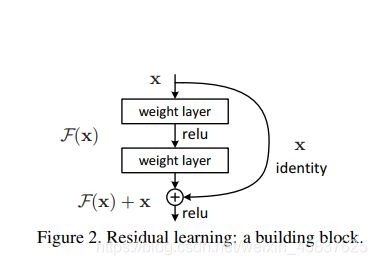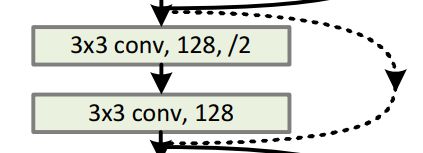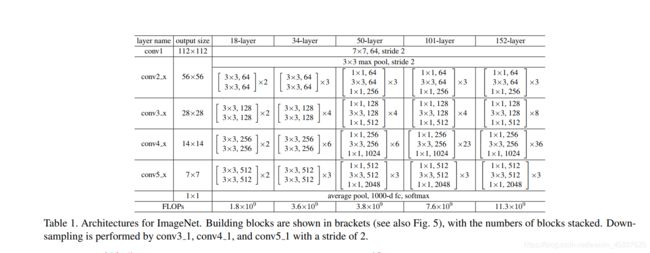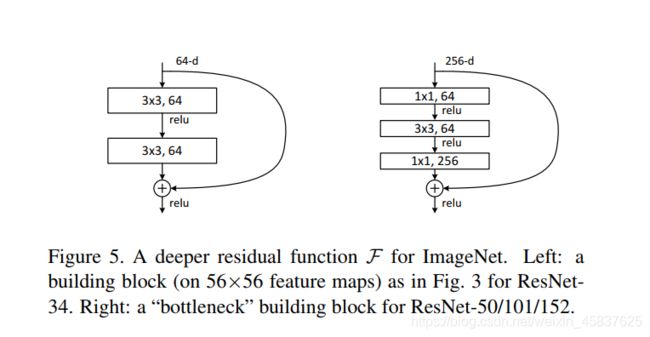卷积神经网络(四)Resnet网络pytorch实现
1.Resnet 主要结构图
2.VGG与resnet34比较
注意虚线和实线的区别:
2.1不需要下采样,直接相加
3.resnet参数结构
4.具有代表性的残差块
5.具体代码实现
5.1先定义适合Resnet34的基础卷积块
#18,34
class BasicBlock(nn.Module):
#因为第一个卷积和第二个卷积的通道数一样,所以这个设置为1
expansion = 1
def __init__(self, in_channel, out_channel, stride=1, downsample=None):
super(BasicBlock, self).__init__()
#Conv(3x3,64) stride=1
self.conv1 = nn.Conv2d(in_channels=in_channel, out_channels=out_channel,
kernel_size=3, stride=stride, padding=1, bias=False)
self.bn1 = nn.BatchNorm2d(out_channel)
self.relu = nn.ReLU()
#Conv(3x3,64) stride=1
self.conv2 = nn.Conv2d(in_channels=out_channel, out_channels=out_channel,
kernel_size=3, stride=1, padding=1, bias=False)
self.bn2 = nn.BatchNorm2d(out_channel)
#残差边
self.downsample = downsample
def forward(self, x):
#
identity = x
#判断是否需要下采样
if self.downsample is not None:
#若需要
identity = self.downsample(x)
#第一次卷积
out = self.conv1(x)
out = self.bn1(out)
out = self.relu(out)
#第二次卷积
out = self.conv2(out)
out = self.bn2(out)
#相加之后传入给激活函数
out += identity
out = self.relu(out)
return out
5.2Resnet50基础卷积块
#50,101,152
class Bottleneck(nn.Module):
#第三个卷积块的通道数是第一个的四倍(64->256) ,前面定义方便后面运算
expansion = 4
def __init__(self, in_channel, out_channel, stride=1, downsample=None):
super(Bottleneck, self).__init__()
#Conv(1x1,64) stride=1
self.conv1 = nn.Conv2d(in_channels=in_channel, out_channels=out_channel,
kernel_size=1, stride=1, bias=False) # squeeze channels
self.bn1 = nn.BatchNorm2d(out_channel)
# Conv(3x3,64) 第一个的时候stride=2 其他就是=1
self.conv2 = nn.Conv2d(in_channels=out_channel, out_channels=out_channel,
kernel_size=3, stride=stride, bias=False, padding=1) #stride=2,stride=1
self.bn2 = nn.BatchNorm2d(out_channel)
#Conv(1x1,256) stride=1
self.conv3 = nn.Conv2d(in_channels=out_channel, out_channels=out_channel*self.expansion,
kernel_size=1, stride=1, bias=False) # unsqueeze channels
self.bn3 = nn.BatchNorm2d(out_channel*self.expansion)
self.relu = nn.ReLU(inplace=True)
self.downsample = downsample
def forward(self, x):
identity = x
#第一次卷积
out = self.conv1(x)
out = self.bn1(out)
out = self.relu(out)
#第二次卷积
out = self.conv2(out)
out = self.bn2(out)
out = self.relu(out)
#第三次卷积
out = self.conv3(out)
out = self.bn3(out)
#是否要进行下采样
if self.downsample is not None:
identity = self.downsample(x)
#相加之后再使用激活函数
out += identity
out = self.relu(out)
return out
6.模型整体代码:
import torch.nn as nn
import torch
#18,34
class BasicBlock(nn.Module):
#因为第一个卷积块和第二个卷积块的通道数一样,所以这个设置为1
expansion = 1
def __init__(self, in_channel, out_channel, stride=1, downsample=None):
super(BasicBlock, self).__init__()
#Conv(3x3,64) stride 要自己定义,因为如果为大卷积块的第一个残差网络,这儿的步长就是2
self.conv1 = nn.Conv2d(in_channels=in_channel, out_channels=out_channel,
kernel_size=3, stride=stride, padding=1, bias=False)
self.bn1 = nn.BatchNorm2d(out_channel)
self.relu = nn.ReLU()
#Conv(3x3,64) stride=1
self.conv2 = nn.Conv2d(in_channels=out_channel, out_channels=out_channel,
kernel_size=3, stride=1, padding=1, bias=False)
self.bn2 = nn.BatchNorm2d(out_channel)
#残差边
self.downsample = downsample
def forward(self, x):
#
identity = x
#判断是否需要下采样
if self.downsample is not None:
#若需要
identity = self.downsample(x)
#第一次卷积
out = self.conv1(x)
out = self.bn1(out)
out = self.relu(out)
#第二次卷积
out = self.conv2(out)
out = self.bn2(out)
#相加之后传入给激活函数
out += identity
out = self.relu(out)
return out
#50,101,152
class Bottleneck(nn.Module):
#第三个卷积块的通道数是第一个的四倍(64->256) ,前面定义方便后面运算
expansion = 4
def __init__(self, in_channel, out_channel, stride=1, downsample=None):
super(Bottleneck, self).__init__()
#Conv(1x1,64) stride=1
self.conv1 = nn.Conv2d(in_channels=in_channel, out_channels=out_channel,
kernel_size=1, stride=1, bias=False) # squeeze channels
self.bn1 = nn.BatchNorm2d(out_channel)
# Conv(3x3,64) 第一个的时候stride=2 其他就是=1
self.conv2 = nn.Conv2d(in_channels=out_channel, out_channels=out_channel,
kernel_size=3, stride=stride, bias=False, padding=1) #stride=2,stride=1
self.bn2 = nn.BatchNorm2d(out_channel)
#Conv(1x1,256) stride=1
self.conv3 = nn.Conv2d(in_channels=out_channel, out_channels=out_channel*self.expansion,
kernel_size=1, stride=1, bias=False) # unsqueeze channels
self.bn3 = nn.BatchNorm2d(out_channel*self.expansion)
self.relu = nn.ReLU(inplace=True)
self.downsample = downsample
def forward(self, x):
identity = x
#第一次卷积
out = self.conv1(x)
out = self.bn1(out)
out = self.relu(out)
#第二次卷积
out = self.conv2(out)
out = self.bn2(out)
out = self.relu(out)
#第三次卷积
out = self.conv3(out)
out = self.bn3(out)
#是否要进行下采样
if self.downsample is not None:
identity = self.downsample(x)
#相加之后再使用激活函数
out += identity
out = self.relu(out)
return out
class ResNet(nn.Module):
#block :BasicBlock Bottleneck
#blocks_num :[3, 4, 6, 3], [3, 4, 23, 3]
#num_classes=1000
def __init__(self, block, blocks_num, num_classes=1000, include_top=True):
super(ResNet, self).__init__()
self.include_top = include_top #看是否有后面的全连接
#定义初始通道数=64
self.in_channel = 64
#第一个卷积层(7x7,64) stride=2
self.conv1 = nn.Conv2d(3, self.in_channel, kernel_size=7, stride=2,
padding=3, bias=False)
self.bn1 = nn.BatchNorm2d(self.in_channel)
self.relu = nn.ReLU(inplace=True)
#(3x3,2) stride=2
self.maxpool = nn.MaxPool2d(kernel_size=3, stride=2, padding=1)
#第一个卷积层结束
#Bottleneck ,64,3
#
#
#
self.layer1 = self._make_layer(block, 64, blocks_num[0])
#
self.layer2 = self._make_layer(block, 128, blocks_num[1], stride=2)
self.layer3 = self._make_layer(block, 256, blocks_num[2], stride=2)
self.layer4 = self._make_layer(block, 512, blocks_num[3], stride=2)
if self.include_top:
self.avgpool = nn.AdaptiveAvgPool2d((1, 1)) # output size = (1, 1)
self.fc = nn.Linear(512 * block.expansion, num_classes)
for m in self.modules():
if isinstance(m, nn.Conv2d):
nn.init.kaiming_normal_(m.weight, mode='fan_out', nonlinearity='relu')
#Bottleneck ,64,3
#Bottleneck ,128,4
#Bottleneck ,256,6
#Bottleneck ,512,3
def _make_layer(self, block, channel, block_num, stride=1):
#下采样初始定义为:None
downsample = None
"""
下采样部分
"""
#当步长不等于1,或者输入通道不等于 4xchannel的时候要进行下采样
#stride=2,这个数值要自己传入的,channel,这个数值也是要自己传入的
#只有这种情况才执行下采样:3个大块,第一个小块开始的时候才执行这个下采样,为了特征图大小维度一致
# : 4个大块。。。。。。。。。。
# :6个大块。。。。。。。。。。
# :3个大块。。。。。。。。。。
if stride != 1 or self.in_channel != channel * block.expansion: #当步长不等于一,In_channel不等于四倍的block.expension
#把特征的维度,宽高都要和前面的搞一致,这样就可以相加了
downsample = nn.Sequential(
nn.Conv2d(self.in_channel, channel * block.expansion, kernel_size=1, stride=stride, bias=False), #stride=2
nn.BatchNorm2d(channel * block.expansion))
#定义一个列表
layers = []
#
#64,64,None,1
#把第一个卷积层传入到列表中 第一个含有下采样,其他的没有
#注意这个block()代表的是所要传入的参数,
layers.append(block(self.in_channel, channel, downsample=downsample, stride=stride)) #stride=2(50) #stride=1(34)
#256
#重新定义4倍
self.in_channel = channel * block.expansion #256,512,1024,2048
#(1,3)
for i in range(1, block_num): #(1到block_num) 不包括block_num (0,block_num)0, #1,2
#block()->Bottleneck()
layers.append(block(self.in_channel, channel)) #256, 64
#256
"""0
inchannel=256,这个就是下采样的那个残差网络块,产生的,因为他是一个块一个块的,用block(self.in_channel=256,channel=64)
#对于这个channel=64这个,self._make_layer(block, 64, blocks_num[0]),这个参数一定要对应,channel里面是64,调用make_layer()的时候
要注意前面传入的block,后面传入的是channel,block里面的参数就是残差网络块的了
终于0明0白
"""
return nn.Sequential(*layers)
#注意参数的对应,
def forward(self, x):
x = self.conv1(x)
x = self.bn1(x)
x = self.relu(x)
x = self.maxpool(x)
x = self.layer1(x)
x = self.layer2(x)
x = self.layer3(x)
x = self.layer4(x)
if self.include_top:
x = self.avgpool(x)
x = torch.flatten(x, 1)
x = self.fc(x)
return x
def resnet34(num_classes=1000, include_top=True):
return ResNet(BasicBlock, [3, 4, 6, 3], num_classes=num_classes, include_top=include_top)
def resnet101(num_classes=1000, include_top=True):
return ResNet(Bottleneck, [3, 4, 23, 3], num_classes=num_classes, include_top=include_top)





